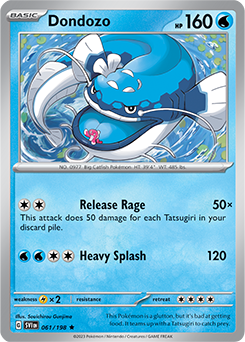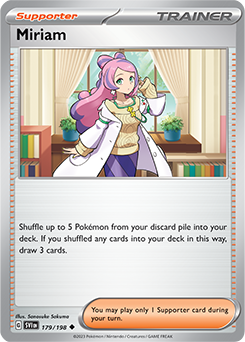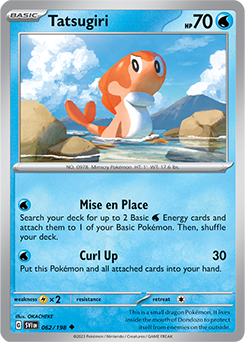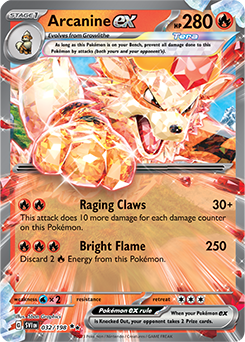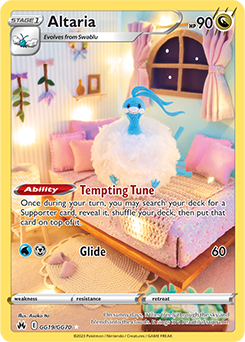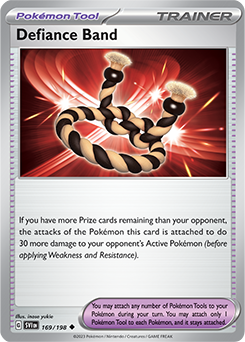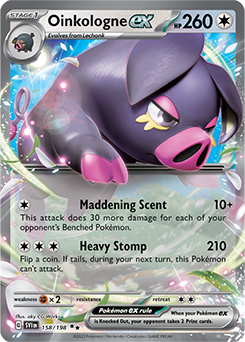Read on below to learn more about Pokémon TCG: Scarlet & Violet.
Pokémon TCG experts share exciting new decks featuring fan-favorite Pokémon.
The Pokémon TCG: Scarlet & Violet expansion welcomes Paldea into the Pokémon TCG with a flurry of powerful Pokémon. Among them are a host who have unique strengths and are eager to get into the action of your next TCG battle. Dondozo, Arcanine ex, and Oinkologne ex aren’t projected to be world-beaters, but that doesn’t mean you can’t enjoy them (and their artwork) all the same—you may even unlock their true potential!
We’ve asked three Pokémon TCG experts to take these cards for a spin and put together decks that are worth a second look when it comes time to battle!
By Xander Pero
Dondozo and Tatsugiri are two of my favorite Pokémon from this new Scarlet & Violet era. I enjoy the storytelling of Pokémon pairs, such as Plusle and Minun, or Oranguru and Passimian. What’s unique about Dondozo and Tatsugiri is that they aren’t just counterparts, but they also have a symbiotic relationship—and their card interpretations reflect this!
Dondozo’s attack, Release Rage, does 50 damage for each Tatsugiri in the discard pile. It stands to reason, then, that when building a deck around Dondozo, our number one priority will be including ways to search and discard Tatsugiri to power up Release Rage. Cards like Level Ball and Ultra Ball will be our primary ways of finding Tatsugiri. Supporters like Professor’s Research and Serena will allow us to discard Tatsugiri once we draw into them.
Let’s take a look at how this all comes together. Dondozo and Tatsugiri are our main Pokémon, so we need as many copies of both as we can fit. Additionally, each Articuno has a purpose: the Articuno from the Pokémon GO expansion boosts all Water-type Pokémon’s attacks by 10 damage, which can be useful to reach specific numbers that we otherwise could not with the 50-damage increment of Release Rage. On the other hand, the Articuno from Sword & Shield—Silver Tempest can potentially soften up a Pokémon VSTAR while making it Paralyzed. Dondozo can then clean up on the following turn.
Most of our Items are dedicated to setting up quickly. To that end, we have 14 “Ball” cards, including two Hisuian Heavy Ball so that we can retrieve Dondozo or Tatsugiri from the Prize cards if needed. Moreover, Trekking Shoes and Pokégear 3.0 contribute to the deck’s speed and synergize nicely with PokéStop. Pokémon Catcher is the one exception to this: Since we will likely need to play a draw Supporter each turn, Boss’s Orders is simply too slow. Serena can bring up Pokémon V, but it is limited by the fact that it cannot target Pokémon ex. Therefore, happy flipping with Pokémon Catcher!
The Supporters are centered around Professor’s Research and Serena, which both provide additional ways to discard Tatsugiri. Cynthia’s Ambition has enough value to warrant a spot since it can also be found by Pokégear 3.0. Finally, Miriam doubles as a draw Supporter and a recovery card. We have only four copies of Dondozo, but the opponent must take six Prize cards to win. Miriam can recover Dondozo or Articuno and draw three cards to boot.
The final pieces of the list are the Pokémon Tools and Energy. Choice Belt and Exp. Share are the Tools of choice. Choice Belt boosts damage against Pokémon V, which can result in easier Knock Outs in a pinch. Exp. Share is needed to conserve Energy since Release Rage requires two attachments without Double Turbo Energy. We have ample Water Energy for single attachments and synergy with Tatusigiri’s attack, Mise en Place. Double Turbo Energy is also necessary because it fulfills Release Rage’s attack cost perfectly.
Your number one priority should be to find Tatsugiri so you can increase the damage output of Release Rage. I like to save Ultra Ball for Tatsugiri, and instead try to get Dondozo with Nest Ball only. You can survive with only two Dondozo at a time (one to attack, one for backup), whereas you need to reach four Tatsugiri as soon as possible. Finding Articuno is important if the additional 10 damage or Paralyzed matters.
Starting with an Active Tatsugiri can be a bit of a pain: you cannot discard all four and simply attack with Dondozo repeatedly. Thankfully, Tatsugiri has great attacks! Mise en Place can accelerate two Water Energy to a Benched Dondozo, which sets up for a future Exp. Share and readies an attacker for the following turn. Tatsugiri’s second attack, Curl Up, puts it back into your hand so you can discard it on the following turn. Keep in mind that you must promote a new Active Pokémon—likely a Dondozo—which may be attacked. I usually use Mise en Place once, then Curl Up if my Tatsugiri was not Knocked Out.
Sequencing your cards correctly can greatly improve your odds of being able to discard multiple Tatsugiri. For example, let’s say you have Level Ball and Professor’s Research in hand with a PokéStop in play. It is correct to use PokéStop before Level Ball, since playing Level Ball reduces the number of Tatsugiri in the deck. Therefore, you are lowering your odds of hitting Tatsugiri off PokéStop. If you also have a Nest Ball in hand, you should use Nest Ball to grab Dondozo before using PokéStop, as doing so increases your odds of hitting Tatsugiri off PokéStop! Practice makes perfect.
One final thing to remember is that you must shuffle in at least one Pokémon with Miriam to draw three cards. Therefore, it can be useful to purposely discard a Dondozo or Articuno so that you can avoid shuffling in Tatsugiri. If Miriam is your only Supporter, you might have to do so anyway.
I’ve had a blast putting together this deck. It’s extremely satisfying to Knock Out Pokémon V in a single attack for a single Energy attachment. Dondozo’s 160 HP makes it exceptionally resilient against other single-Prize attackers. If you can fish out your Tatsugiri in time, you’re in for a fun match with Dondozo!
Natalie says: Single-Prize Pokémon almost always have a slight edge over multi-Prize Pokémon because of the Prize trade, especially when they can dish out 200-plus damage! I think that Xander’s deck mitigates the high setup requirements that Dondozo has, with tons of Pokémon search options and multiple Hisuian Heavy Ball. Prizing a single Tatsugiri in this deck is incredibly detrimental, so being able to find Hisuian Heavy Ball early is super important! Overall, Dondozo is a super exciting deck to try out, and to try and trade favorably against other decks!
Ross says: I really like Xander’s inclusion of both Articuno. Articuno’s Wild Freeze hitting for 80 damage and Paralyzed, followed up by 210 from Dondozo, will Knock Out many popular Pokémon VSTAR and ex in the format. That’s an effective combination. It also gives this deck another attack option without introducing a multi-Prize Pokémon as a target. I also like Pokémon Catchers in more combo-heavy decks like this that can’t afford to use Supporters for anything but setup early on.
I am a little surprised Xander decided not to include Raihan. Raihan would give this deck another way of powering up an attacker in one turn when you don’t have Double Turbo Energy. Going with Raihan over Exp. Share would also keep your options open for attaching Choice Belt.
By Ross Cawthon
The Scarlet & Violet expansion brings back Arcanine ex (17 years after the first one released!), this time as a Tera Pokémon. Like the Pokémon V from the Sword & Shield era, Pokémon ex have higher HP, higher attack powers, and give up two Prize cards when they’re Knocked Out. However, some Pokémon ex like Arcanine ex bring a key difference: they evolve from regular single-Prize Pokémon.
This is an important detail. For example, before the powerful Lugia VSTAR card can be brought into play, the weaker Lugia V must be in play for a turn. In many games, an opponent will target and Knock Out a Lugia V immediately, and you will be down two Prize cards before even attacking.
In contrast, Arcanine ex evolves from Growlithe. While Growlithe has just 90 HP, it only gives up one Prize card. This means you can maintain the possibility of a big attack with Arcanine ex next turn while only having single-Prize Pokémon on the field for your opponent to target. This could stop opponents from taking big leads against you.
Arcanine ex’s big attack is Bright Flame, which requires 3 Fire Energy to do 250 damage. The best Energy accelerator for Fire-type Pokémon in the Standard format is Magma Basin. However, Magma Basin can only charge Pokémon on the Bench. This means that every turn, you’ll likely need to power up a Pokémon on the Bench, and then make it Active to attack.
One way to address this challenge is with a “pivot” Pokémon—a Pokémon that you try to place in the Active Spot every turn, with the intent of having it return to the Bench while you attack with something else. Recently, the most popular pivot Pokémon have been Comfey and Mew. Combined with a card like Air Balloon, these cards allow you to use an Ability, then retreat for free each turn, allowing you to bring up your charged attacker. Air Balloon has now rotated out of the Standard format, though, so many decks will switch to the new Beach Court Stadium to remove the Retreat Cost for their Basic Pokémon in play. However, since this deck focuses on Magma Basin, we can’t play Beach Court. This conundrum led me to a pivot Pokémon not seen in too many decks: Altaria.
Altaria is best known for its Tempting Tune Ability, which allows you to search for any Supporter and put it on top of your deck. This is a powerful Ability, but the second reason I think Altaria fits this deck is its Retreat Cost: zero! Altaria can retreat for free every turn and be the “pivot”.
Here is the list I’ve gone with:
Besides Arcanine ex, I have Moltres for early-game attacking and Radiant Charizard for the late game. A great partner Pokémon to Altaria was Oranguru, which could draw you the top card of your deck after Altaria put a Supporter there. Since Oranguru has rotated out, I’ve decided to try a new card, Skwovet, which also draws the top card of your deck. While the cost is higher (putting your whole hand to the bottom of your deck), Skwovet has the benefit of being searchable via Level Ball. And at any rate, there are also situations in which putting your hand back in your deck is an advantage, such as when you want to use Professor’s Research but do not want to discard any Arcanine ex or Magma Basins. I’ve included one Lumineon V for instances where you don’t have the resources early in the game to find both Altaria and Skwovet.
Professor’s Research and Serena are good Supporters to get you going and put Fire Energy in the discard pile. Serena also gives you the option of targeting Benched Pokémon V, like the popular Genesect V, which is weak to Fire. Raihan is a key Supporter midgame; you can have an Arcanine ex with zero Energy, but in one turn it can be powered up to do 250 damage with Raihan plus Magma Basin plus an Energy attachment. And thanks to Altaria, finding Raihan shouldn’t be a problem. Klara also works well with Radiant Charizard—with this Supporter, you can recover Radiant Charizard and Basic Fire Energy for your next attack. In the late game, you’ll be able to pull off an attack for just a single Energy thanks to its Excited Heart Ability!
In addition to many Ball cards to find Pokémon, I have three Switch cards in case I can’t get an Altaria into the Active Spot or need to get Arcanine ex back to the Bench. For some extra damage, I have the new Defiance Band in addition to Choice Belt. Defiance Band gives you some flexibility in that it adds damage against any Pokémon (if you are behind in Prizes), rather than just Pokémon V. For example, a Moltres can KO the popular Cramorant with a Defiance Band.
Arcanine ex provides an opportunity to do big damage without placing vulnerable multi-Prize Pokémon in play until you’re ready. Give this deck a try to see if it has the firepower to compete in the new Standard format.
Xander says: With Magma Basin and Raihan, Ross has added many ways of powering up Arcanine ex. After you discard Energy with Bright Flame, you can simply attach one more Energy and use Raging Claws after Arcanine ex has taken some damage. Defiance Band and Choice Belt improve your damage output up to 280, which is enough to Knock Out relevant Pokémon VSTAR such as Giratina VSTAR and Lugia VSTAR.
One card I’d like to see is a Boss’s Orders. Because Serena can only target Pokémon V, there is a subtle weakness in targeting Pokémon ex or single-Prize Pokémon. Altaria can find Boss’s Orders on demand. Pyukumuku—because of Level Ball and its Pitch a Pyukumuku Ability—can provide synergy with Altaria, as well.
Natalie says: I love the addition of Altaria to this deck; it fills the role of both being a pivot and helping you find more cards! Combine Altaria with Skwovet, and I don’t think this deck will struggle with finding Supporters throughout the game—definitely a nice bonus! I also really like that Choice Belt and Defiance Band are included. Both Arcanine ex and Radiant Charizard only do 250 damage; the extra 30 damage pushes both attacks over the 280 threshold, which would let you take a one-hit KO on most Pokémon VSTAR. This is a very aggressive deck that I think will run over a lot of opponents in the early game!
Oinkologne ex is the latest iteration of one of the most classic Pokémon TCG deck archetypes: tank and heal. With 260 HP, Oinkologne ex is definitely no slouch when it comes to the “tank” part in absorbing attacks, staying pretty much on par with Pokémon VSTAR. Oinkologne ex also has two good attacks in Maddening Scent and Heavy Stomp: while Heavy Stomp does a decent amount of damage, the Energy cost and the potential downside of not attacking next turn often makes it tough to use. Maddening Scent is a nice callback to Zoroark’s Mind Jack attack, which saw tons of success in the Standard format of its time.
However, the real strength of Oinkologne ex is that it evolves from the single-Prize Lechonk. Recently, decks that use Pokémon VMAX or VSTAR to try and absorb attacks have struggled against aggressive strategies that use Boss’s Orders to Knock Out the evolving Pokémon V when it doesn’t have as much HP. While that strategy is still possible against Lechonk, they only give up a single Prize card each, while the Pokémon V that evolve into Pokémon VSTAR and VMAX give up two Prize cards.
This significantly restricts the power that aggressive decks have against Oinkologne ex, because the only two-Prize Knock Out is the star Pokémon itself! With that, I wanted to build an Oinkologne ex deck in a way to force my opponent to Knock Out as many Oinkologne ex as possible. To do this I wanted to have two things: healing cards to undo my opponent’s last attacks and disruption cards to prevent my opponents from announcing attacks. With that in mind (and after some trial and error), here’s my deck list:
The first thing to notice about this deck is the lack of Pokémon: it’s literally just the Oinkologne and Bibarel lines! The reason for this is, as I mentioned earlier, to force my opponent to Knock Out as many Oinkologne ex as possible. Because of this, the list includes four Lechonk and four Oinkologne ex. You always want to evolve your Lechonk as soon as possible, and carrying the maximum count of Oinkologne ex helps with that. Yes, your opponent can chase Bibarel and take easy Prize cards off it, but I believe that it is still a necessary addition. With this deck, you’ll often have to play Supporter cards that don’t draw cards. For example, using Cheryl on consecutive turns will often leave you with no cards remaining to play, making Bibarel a good fit to refill your hand.
Speaking of Cheryl, I believe that it’s the best healing card for this kind of deck. While Oinkologne ex is a Colorless-type Pokémon and thus can use Cheren’s Care, having to pick up the Oinkologne ex and all cards attached to it can actually be a downside in this strategy. Your opponent may play a Boss’s Orders to Knock Out the Lechonk you just put down, which means the Oinkologne ex would be stuck in your hand and you would be unable to draw cards with Bibarel!
Another huge upside of Cheryl is that it doesn’t heal just one of your Evolution Pokémon, it heals them all. A common pattern with this deck is that after your opponent attacks your Oinkologne ex, you will retreat or switch a Benched Oinkologne ex to the Active Spot and your opponent will attack it again. Then, you play Cheryl and heal off the damage from both attacks. While Cheryl does discard all Energy from the Pokémon it heals, Maddening Scent only costs a single Energy to use, so you can attach one again and get right back into the action.
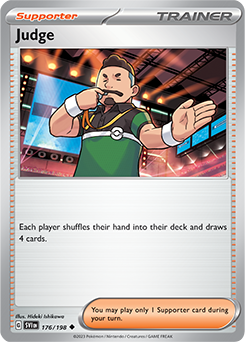 Two other Supporters I chose to include in this deck were Judge and Boss’s Orders. Judge is a great card in Bibarel decks—it constantly restricts your opponent to a low hand size, which prevents them from assembling big combinations of cards. Boss’s Orders is also a fantastically versatile card. You can use it to bring up Pokémon that you already have attacked once to finish them off, bring up a Pokémon with a high Retreat Cost to stall for time, or even pick off support Pokémon with low HP, such as Comfey.
Two other Supporters I chose to include in this deck were Judge and Boss’s Orders. Judge is a great card in Bibarel decks—it constantly restricts your opponent to a low hand size, which prevents them from assembling big combinations of cards. Boss’s Orders is also a fantastically versatile card. You can use it to bring up Pokémon that you already have attacked once to finish them off, bring up a Pokémon with a high Retreat Cost to stall for time, or even pick off support Pokémon with low HP, such as Comfey.
The last Supporter in this deck is Professor’s Research; two copies of it are included for extra draw power in the middle of the game. It’s there because, although you’ll typically want to play either Judge or Cheryl, having the option of drawing seven cards at once is still as attractive as ever.
The four Nest Balls and four Ultra Balls are there to help you find your Pokémon early on. Ultra Ball does double duty in this deck as both a way to find Oinkologne ex and a way to lower the size of your hand for Bibarel’s Industrious Incisors. There are also two copies of Switch in case you start with Bidoof as your only Pokémon, or you need to move your damaged Oinkologne ex to the Bench. Since our strategy revolves specifically around Judge and Cheryl, the four copies of Pokégear 3.0 are there to help find those Supporter cards more consistently.
There are two more Trainer cards in the deck that both work thanks to Oikologne ex’s lack of an Ability. Against decks that try to attack Oinkologne ex multiple times, Full Face Guard can prevent up to 60 damage on a single Oinkologne. Don’t forget that you can still attach it to Bibarel if all your other Pokémon have Tools on them, so you can draw more with Industrious Incisors. Path to the Peak also complements this strategy, shutting down Abilities like Miraidon ex’s Tandem Unit, Genesect V’s Fusion Strike System, and Lugia VSTAR’s Summoning Star, which is especially powerful when combined with Judge.
Since Oinkologne ex’s attacks use Colorless Energy, you get to use the strong effects of multiple Special Energy available in the current format. V Guard Energy synergizes with our deck especially well, helping to prevent damage. The same is true for Lucky Energy; ideally, Oinkologne ex would get attacked multiple times, which would enable you to draw multiple cards from it. Double Turbo Energy functions both as an Energy to use Maddening Scent and as a way to pay for Oinkologne ex’s Retreat Cost. Finally, the deck includes one Gift Energy because you do need a high amount of Energy when Cheryl discards them, and the “gift” can be valuable to draw cards in the early game.
I would recommend giving this deck a shot! It is incredibly annoying to play against with all the disruption and healing—and it is surprisingly effective!
Xander says: Oinkologne ex is a chunky attacker. Its first attack, Maddening Scent, caps at 160 damage. But when combined with Cheryl, Full Face Guard, and V Guard Energy, Oinkologne ex can survive opposing attacks and do significant damage over multiple turns. Importantly, Maddening Scent only requires a single Colorless Energy—you have Special Energy at your disposal and can effectively meet its cost after using Cheryl. Because Oinkologne ex isn’t the most aggressive attacker, I like the defensive options in Judge and Path to the Peak. Other decks require more moving pieces to function, so these cards can throw a wrench in an opponent’s plans.
Ross says: It’s dangerous to face Oinkologne ex. My favorite part of Natalie’s deck is the synergy between her Supporters and Bibarel. It’s typically difficult to use a card like Cheryl multiple times per game, as the turn you use it you usually aren’t drawing any extra cards. Bibarel’s Industrious Incisors solves that problem, and there are very few Pokémon in Natalie’s deck to “clog” her hand.
Natalie makes a good argument for going with Cheryl over Cheren’s Care in this build. This approach relies on using the Maddening Scent attack a bit more often. Its reliance upon your opponent playing down Pokémon does worry me, but Heavy Stomp is likely enough to Knock Out most Pokémon in two hits (as long you can hit for at least 100 damage). This strategy is also aided by Scoop Up Net getting rotated out of the Standard format.
About the Writer

Ross Cawthon
Ross Cawthon is a longtime player, starting to play tournaments in 2000. He is the only player to compete in all 18 Pokémon TCG World Championships, finishing as a finalist in 2005 and 2011, and a semifinalist in 2016. He is known for creating many new “rogue” decks over the years. Ross has a Ph.D. in astrophysics and studies dark energy (not to be confused with Darkness Energy cards).
About the Writer

Natalie Millar
Natalie has been playing Pokémon casually since late 2013 but started attending more competitive tournaments in late 2017. She won the first Regional Championships back from the pandemic in her home city of Brisbane, Australia, and has been attending most major tournaments since. Outside of Pokémon, she studied psychology, but it doesn’t help with reading opponents as much as you would think. You can find her at most major tournaments and can follow her on Twitter at @nataliem9999.
About the Writer

Xander Pero
Xander Pero is a contributing writer for Pokemon.com. He was an avid fan until discovering sanctioned tournaments in 2009. He formerly traveled often for the Top 16 circuit, but now spends his time focusing on university, where he studies industrial engineering. You can find him at various tournaments, as well as on Twitter at @xanderpero.
Source: Pokemon.com
Source: Pokemon

